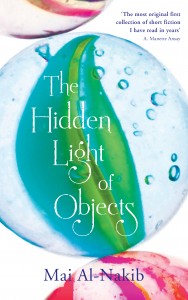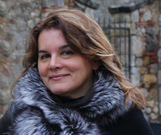Perhaps the strongest element the author shares with her characters is the overwhelming desire to recreate and re-imagine the place where she grew up: a brave, cosmopolitan, outward-looking land that existed not so long ago. —Natalia Sarkissian
The Hidden Light of Objects
by Mai Al-Nakib
Bloomsbury Qatar Foundation Publishing, 2014
Winner 2014 Edinburgh International Book Festival First Book Award
US release January 2015
237 pp. $25.00
.
KUWAITI AUTHOR MAI AL-NAKIB’S fiction debut, The Hidden Light of Objects—a collection of ten short stories set largely in the Middle East—transports the reader to a land of memory and secrets by way of objects. A Chinese apple, Mr. Potato Head’s smile, a packet of playing cards wrapped in fuchsia paper, a melted candle stub, a carved wooden bear, a stamp, a Kashmiri shawl—all these have the power to whisk readers off to a place or a time that no longer exists. As the narrator in the first story of the collection, “Chinese Apples,” explains:
Story objects are cobwebs across space and time. When you think it has never happened to anyone else before, a story object proves you wrong, though you won’t always know you have been proven wrong. Most people’s stories are hidden away. Objects may provide the only chance—unlikely, impossible though it may be—to unravel kept secrets. [10]
Thus Al-Nakib proceeds to unravel secrets in the stories of the collection using the trope of objects as her lens. In “Echo Twins,” for example, a long-hidden object is both metaphor and synecdoche and answers a central mystery. At age 18, yellow-haired, pale-skinned Kuwaiti twins Mish‘al and Mishari finally receive their absent British father’s legacy: a locked box. On the night of their mother’s death, they sit in the courtyard of their mud brick home, the box between them:
At midnight, in the white light of a moon turning waves into plains of snow, the twins carefully unwrapped their legacy. The muslin, brown from years of wind storms and rain, disintegrated to dust between their fingers. The tin was rusted, the lock no longer locked. The brothers caught their breath as they removed from the box a heavy object not immediately clear in the shadows along the shore. Mish‘al held it up to the moon. [52]
As they pass the long-anticipated object back and forth under the moonlight, they understand that they hold their peripatetic, long-gone father in their hands.
In “Amerika’s Box,” an allegorical tale of Kuwait’s quixotic relationship with the United States, charred objects symbolize the residue of a great loss. When their daughter is five years old, the Ahmeds change their daughter’s name to Amerika, in honor of the nation that routed the Iraqi invaders in the First Gulf War. Amerika soon finds that people are generally exuberant and approving. Only her religion teacher frowns. “An infelicitous name for an infelicitous little girl. You are doomed, my dear.” [197] But Amerika, who pronounces her name “Amreeka,” shrugs off the teacher’s omens. Instead, she watches satellite television, reads Nancy Drew and collects all manner of Americana, twenty-five objects at a time. A Baby Ruth bar, green jellybeans, a folded page from an Archie comic, an Abraham Lincoln penny. She secrets these in a handmade box with twenty-five compartments.
Then the Twin Towers come down and everything changes. Suddenly Amerika’s name and her objects trigger rage and fury. When war comes to the region again, Kuwaitis—now less sympathetic—stay inside, dodging Scud missiles from Iraq. But not Amerika. She dances on the beach with her box full of treasures, tempting fate:
Amerika pulls her box to her chest and dances harder, the wind knitting lace with her hair. She twirls and dips and kicks up her heels, always the letter k at heart. [211]
In the title story, “The Hidden Light of Objects,” a series of objects symbolize and evoke a stolen past. A Kuwaiti mother is abducted by retreating soldiers after the Iraqi invasion of Kuwait. Held in captivity in Iraq for ten years, the mother’s belongings, the objects she loved and left behind in Kuwait, save family members from utter despair. The girls have memorized where their missing mother kept her Betty Crocker cookbook, her string of pearls, her hand-painted champagne flutes. They are meticulous in caring for these things,“[t]heir broken, damaged lives held together by the painstaking placement of objects that belonged to their lost mother.” [236]
Meanwhile, their mother, in her cell in Iraq, remembers the things that belonged to her—her “fine lace pieces from Burano, clumps of silver jewelry from Peshawar, […] [her] mother’s string of delicate pearls.”[234] Each of these objects “embalm[s] the kernels of [her] life.” [234] Thinking of them daily—as if silently worrying prayer beads—offers her hope:
Every one of us had something in that windowless space […] that stood for home. For me it was counting objects. Not quite counting them. Naming them, sorting them into categories, telling their histories, and trying to remember where they would be in my house. […] A litany of objects. My home for a decade. [226-227]
Objects provide the only chance to cling to what is irrevocably gone. In addition, they serve as signposts to chart the future. As Al-Nakib states in a recent interview in Jadaliyya:
Feelings or affects are composed through our encounters with bodies—both animate and inanimate. We often do not pay sufficient attention to the ways in which inanimate objects intersect with animate life or, even further, the ways in which the division between inanimate and animate is a normative construction rather than an essential opposition.
Many of the ten stories involve characters who are either Kuwaiti or are connected to the country. The stories weave familiar events (from the invasion of Kuwait, to the Israeli Palestinian conflict, to the civil war in Lebanon, to the war in Iraq) into their tapestries. However, the focus is not on politics, but on the lives of the people of the region as they are touched by these events.
The stories are framed by ten vignettes that function, as the author herself says, “like Joseph Cornell boxes, little memory capsules” [in an email from the author]. In other words, the vignette/boxes become echo-chamber objects themselves. They revisit moments of the past in order to heighten the narrative that follows. Vignette II, for example, which precedes “The Echo Twins,” describes an age of lost innocence. In the pre-1991 halcyon era, Kuwaiti middle-schoolers take boat trips to the Kuwaiti island of Failaka, with its marble ruins built by Alexander the Great. Continuously inhabited since Alexander’s time, Failaka was forcibly depopulated and mined during the 1990 Iraqi invasion. Likewise, in “The Echo Twins,” innocence is lost; two brothers learn something about their father, and they must move on.
Throughout the book, Al-Nakib’s language of loss is unsentimental yet striking and lush. The author—whose mother tongue is English (it was her Kuwaiti mother’s first language as well)—evokes the land and its inhabitants with unusual juxtapositions, proximities and linguistic contrasts:
Mama Hayat stopped breathing in the early evening, around the hour the sun turns the sky above the horizon the color of a bruise. [29]
In the middle [of the courtyard] was a sheltering sidr tree ringing with sparrows and red-vented bulbuls. [30]
Abla Nada was tightly wound, a pinprick of a woman, with a face as thick as coffee. Her head was securely bandaged in black, a hijab covering her hair, her forehead down to her eyebrows, half her cheeks, and most of her chin. [197]
But she is possibly most exuberant when she writes about language itself:
The grandest thing Amerika learned was the language. Not just English…American. She rolled her tongue around its rs like a parrot, owned its nasal crescendos and punchy confidence. American pried open a world of wonder for Amerika. [199]
This book celebrates Al-Nakib’s love of the English language. Although born in Kuwait, Al-Nakib was just a few months old when her parents moved to London, then to Edinburgh, then to St. Louis, Missouri. When she moved back to Kuwait at age six, her parents enrolled her at the American School of Kuwait. She received a bachelor’s degree in English literature from Kuwait University and then a PhD from Brown University. She is Associate Professor of English and Comparative Literature at Kuwait University.
Much of Al-Nakib’s academic scholarship focuses on cultural politics in the Middle East in relation to the philosophy of Gilles Deleuze. She has absorbed his ideas, “his negotiations about how to live in the world,” so completely that they are part of who she is. “Some people turn to religion to give them faith. But for me it has always been literature and Deleuze.” In her fiction, it is Deleuze’s affirmation of literature as life—as indeterminate becoming and openness—that is most prominent She also identifies Roland Barthes’ Camera Lucida as an influence on the collection, though not one she recognized until it was already complete. In Camera Lucida, Barthes tries to recover his dead mother through photographs, accidentally discovering her essence in an unfamiliar picture. Ultimately, the search “is a melancholic exercise,” Al-Nakib explains, “rather than a process of mourning, because you continue to want to hold on to the lost object, to never let it go.”
Although the stories in The Hidden Light of Objects are not strictly autobiographical, the author says that they include autobiographical elements. Perhaps the strongest element the author shares with her characters is the overwhelming desire to recreate and re-imagine the place where she grew up: a brave, cosmopolitan, outward-looking land that existed not so long ago. The author and these stories—her objects—are a pathway to locate the glimmer, the light, the truth of what was and what still may be. These stories are our ticket there and her way home.
—Natalia Sarkissian
.
Natalia Sarkissian has an MFA in Writing from Vermont College of Fine Arts, an MA in art history and an MBA in finance from The University of Texas at Austin. She has worked at the National Gallery of Art in Washington DC and at the Huntington Art Gallery in Austin, Texas. Her writing and photographs have been published in the US and Italy by the University of Texas Press, IPSOA publishers, Numéro Cinq Magazine, Corriere della Sera, Tuscany Press, and others. She has been an editor and contributor at Numéro Cinq since 2010.
.
.


